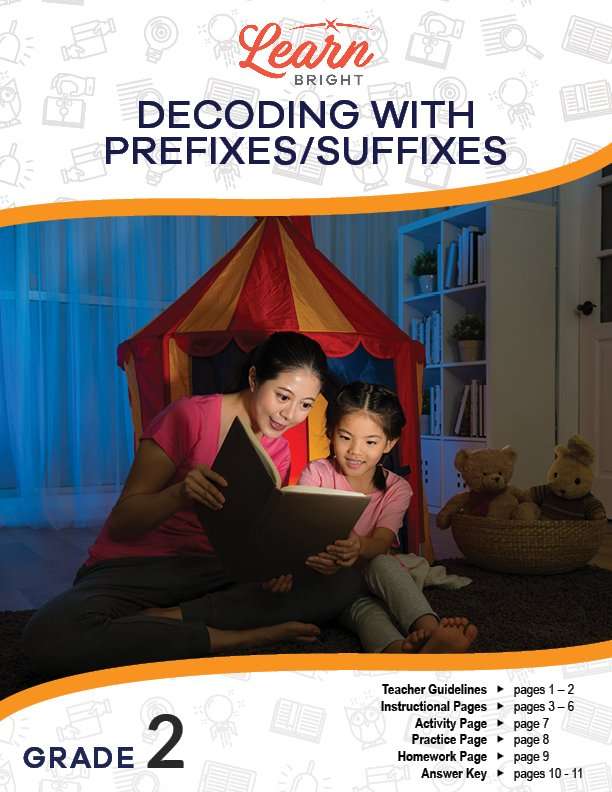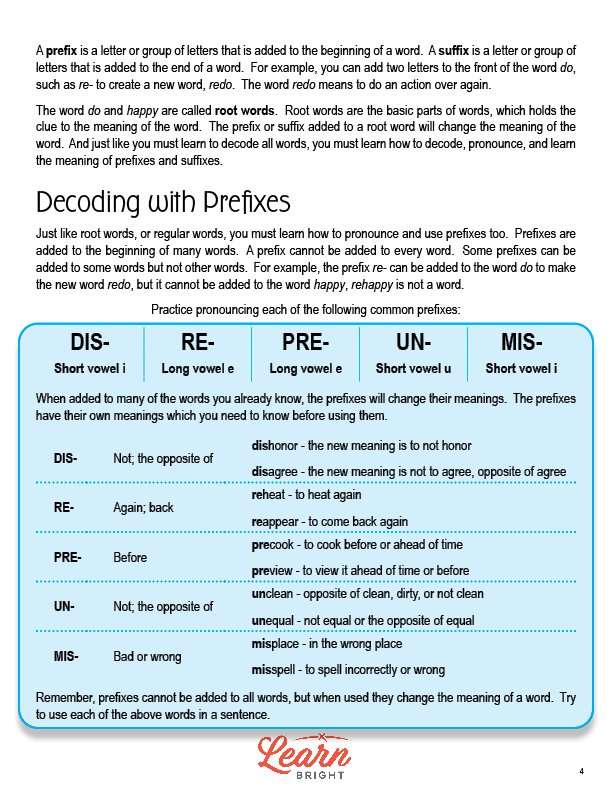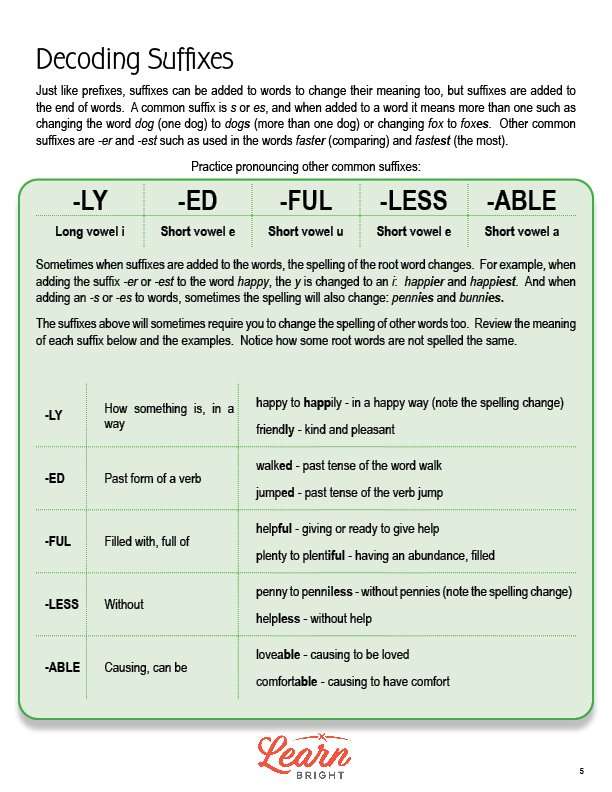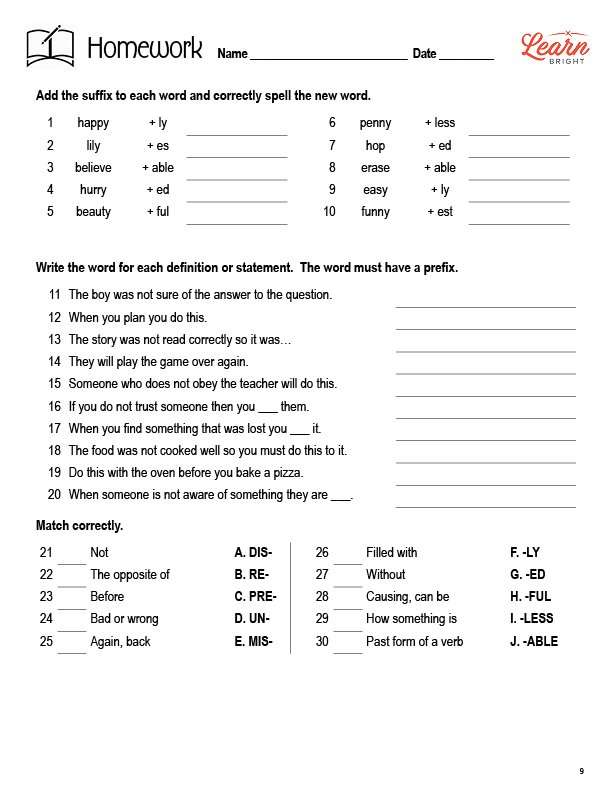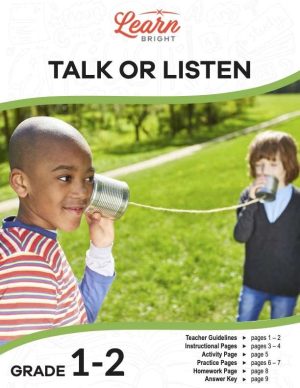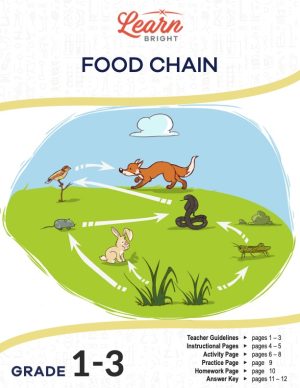Description
What our Decoding with Prefixes/Suffixes lesson plan includes
Lesson Objectives and Overview: Decoding with Prefixes/Suffixes lesson plan combines decoding with learning the most common prefixes and suffixes. A list of prefixes is provided, along with their meaning and examples of words that use them. The same chart is included for suffixes. At the end of the lesson, students will be able to decode words with common prefixes and suffixes. This lesson is for students in 2nd grade.
Classroom Procedure
Every lesson plan provides you with a classroom procedure page that outlines a step-by-step guide to follow. You do not have to follow the guide exactly. The guide helps you organize the lesson and details when to hand out worksheets. It also lists information in the orange box that you might find useful. You will find the lesson objectives, state standards, and number of class sessions the lesson should take to complete in this area. In addition, it describes the supplies you will need as well as what and how you need to prepare beforehand. To prepare for this lesson ahead of time, you can pair students for the activity and copy the handouts.
Options for Lesson
Included with this lesson is an “Options for Lesson” section that lists a number of suggestions for activities to add to the lesson or substitutions for the ones already in the lesson. If you’d like to add to the lesson activity, you could use additional words. As an additional activity, you could create suffix/prefix notecards and have students use them to add root words. You could also conduct a Prefix/Suffix Spelling Bee, where students must spell words with prefixes/suffixes correctly, and then use that prefix or suffix correctly in another word. Students could also create posters that show each prefix and suffix, along with related words and images. You could create a Prefix/Suffix Poster for the class, and have students add words to it as they find them. Finally, you can plan a prefix/suffix day where students use them as often as possible throughout the day.
Teacher Notes
The teacher notes page includes a paragraph with additional guidelines and things to think about as you begin to plan your lesson. It notes that this lesson includes common prefixes and suffixes, which are an important thing to understand when decoding words. You can teach this lesson along with other lessons about prefixes and suffixes. This page also includes lines that you can use to add your own notes as you’re preparing for this lesson.
DECODING WITH PREFIXES/SUFFIXES LESSON PLAN CONTENT PAGES
Decoding Words
The Decoding with Prefixes/Suffixes lesson plan includes three pages of content. This lesson begins by telling students that, to decode word, you need to understand the sounds of letters, letter patterns, and letter-sound relationships. These will all help you correctly pronounce words. Decoding helps you learn new words. If you can sound out a word, you might also be able to figure out its meaning.
All words have a meaning or definition. You already know the meaning of many different words, like happy or do. Every word has a definition, but the definition of a word can change if you add some letters to the beginning or end of the word. We call these affixes. There are two types of affixes: prefixes and suffixes. Prefixes are added to the beginning of a word, and suffixes are added to the end. If you add re- to the beginning of the word do, you get the word redo. In this case, re- is a prefix.
We call words without prefixes or suffixes root words. They’re the basic parts of a word, and are often the most important part of the word for figuring out the meaning. In order to decode words, you need to learn how to decode, pronounce, and learn the meaning of prefixes and suffixes.
Decoding with Prefixes
We add prefixes to the beginning of words (but not every prefix goes with every word!). Re- can be added to do to create redo, but cannot be added to happy, because rehappy is not a word. The lesson includes a helpful table of some common prefixes and encourages students to practice pronouncing each prefix.
Dis- has a short vowel i sound and means not or the opposite of. Some example words with this prefix are dishonor and disagree. Re- has a long vowel e sound and means again or back. Some words with this prefix are reheat and reappear. Pre- has a long vowel e sound and means before. Some words with this prefix are precook and preview. Un- has a short vowel u sound and means not or the opposite of. Some words with this prefix are unclean and unequal. Mis- has a short vowel i sound and means bad or wrong. Some words with this prefix are misplace and misspell.
It’s important to remember that we can’t use all prefixes with all words. When we use prefixes, they change the meaning of a word.
Decoding Suffixes
Suffixes are similar to prefixes but we add them to the end of a word instead of the beginning. One common suffix is -s or -es, which we use to make words plural (dog becomes dogs, meaning there is more than one dog). Two other common suffixes are -er and -est, which we use to create words like faster and fastest. These are comparison words.
The lesson includes a helpful table of some common suffixes and encourages students to practice pronouncing each of them. The suffix -ly has a long vowel i sound and means how something is or in a way. Some words with this suffix are happily and friendly. The suffix -ed has a short vowel e sound and means the past form of a verb. Some words with this suffix are walked and jumped.
Next, the suffix -ful has a short vowel u sound and means filled with or full of. Some words with this suffix are helpful and plentiful. The suffix -less has a short vowel e sound and means without. Some words with this sufix are penniless and helpless. Finally, the suffix -able has a short vowel a sound and means causing or can be. Some words with this suffix are loveable and comfortable.
Like prefixes, we can’t use every suffix with every word. We add prefixes and suffixes to words that you might already know the meaning of and how to pronounce. We add them to the beginning or the end of the root word, and they change the the meaning of the word. They can also change the structure of a sentence. We can’t use happy and happily in the same way. The lesson includes some examples of this.
You can practice recognizing words with prefixes and suffixes while you’re reading to strengthen your understanding of this subject.
DECODING WITH PREFIXES/SUFFIXES LESSON PLAN WORKSHEETS
The Decoding with Prefixes/Suffixes lesson plan includes three worksheets: an activity worksheet, a practice worksheet, and a homework assignment. You can refer to the guide on the classroom procedure page to determine when to hand out each worksheet.
WRITING SENTENCES ACTIVITY WORKSHEET
Students will work with a partner to complete the activity worksheet. Each pair will write a sentence for each word, first without a prefix or suffix and then with different prefixes or suffixes. For example, they will write a sentence for the word cook, and then for the words precook, cooked, and uncooked.
Students may work either alone or in groups for this activity.
ADDING PREFIXES/SUFFIXES PRACTICE WORKSHEET
The practice worksheet asks students to add the correct prefix or suffix to words in sentences. They will also write a sentence that uses a word with a prefix and a sentence with a word with a suffix.
DECODING WITH PREFIXES/SUFFIXES HOMEWORK ASSIGNMENT
The homework assignment asks students to complete three short exercises. For the first, they will add a suffix to each word and correctly spell the new word. For the second, they will write the word for each of the given definitions or statements, making sure that each word has a prefix. Finally, for the third, they will match prefixes and suffixes to their meanings.
Worksheet Answer Keys
This lesson plan includes answer keys for the practice worksheet and the homework assignment. If you choose to administer the lesson pages to your students via PDF, you will need to save a new file that omits these pages. Otherwise, you can simply print out the applicable pages and keep these as reference for yourself when grading assignments.

